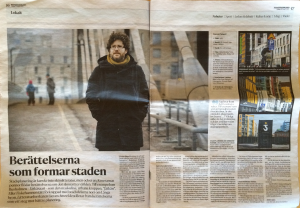Talking today at Turku University / “Being There” in Fictional Worlds -seminar about research conducted together with Terhi Ainiala.
https://www.utu.fi/fi/yksikot/hum/ajankohtaista/uutiset/Sivut/presence-cfp.aspx
Abstract below:
Toponyms as Prompts for Presencing Place –
Making Oneself at Home in the Narrated City
Lieven Ameel & Terhi Ainiala
In our presentation, we will examine toponyms as triggers of a sense of place. Place names may act as delineators and activators of a literary storyworld, not only in the way they function as references to spots on a mental map, but also, and perhaps in particular, as moral, socio-economic and aesthetic demarcations.
We will analyse the function of toponyms in a selection of contemporary Finnish novels set in Helsinki, including texts by Rosa Liksom, Kjell Westö, M.Y. Joensuu, and Antti Tuomainen, and drawing on recent writings by Hans Ulrich Gumbrecht on presence (2004) and by Sten Pultz Moslund on “topopoetic reading” (2011). The literary analysis will be juxtaposed with a survey of Finnish and non-Finnish readers’ experiences of place names in Helsinki novels. The findings of this two-pronged approach underscore the challenges involved in translating the sense of place evoked by any given storyworld across the confines of a specific temporal, geographical and cultural context.
References
Gumbrecht, Hans Ulrich 2004: The Production of Presence: What Meaning Cannot Convey. Stanford: Stanford UP.
Pultz Moslund, Sten 2011: “The Presencing of Place in Literature: Toward an Embodied Topopoetic Mode of Reading.” In Tally, Robert T. (ed.): Geocritical Explorations: Space, Place, and Mapping in Literary and Cultural Studies. New York: Palgrave Macmillan, 29-46.
Further reading:
Ainiala, Terhi ─ Minna Saarelma ─ Paula Sjöblom 2012: Names in Focus. An Introduction to Finnish Onomastics. Helsinki: Finnish Literature Society.
Ameel, Lieven 2015: “‘It’s six a.m., do you know where you are?’ Framing the Urban Experience in Literary Beginnings.” In Ameel, Lieven; Finch, Jason & Salmela, Markku (eds.): Literature and the Peripheral City: Literary Explorations. London: Palgrave, 40-55.


